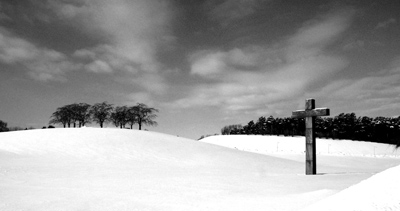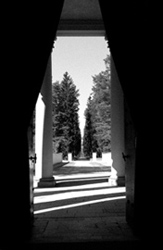You are in: Home page > Magazine Archive > Seeing the invisible in the visible.

Carlotta Torricelli
Seeing the invisible in the visible.
Re-velations in the Swedish landscape.

Erik Gunnar Asplund and Sigurd Lewerentz, Woodland Cemetery, Stockholm, 1915-1961. Photograph by Carlotta Torricelli, February 2010.
“In these Nordic lands of Scandinavia (…) pagan elements are seen as, in the literal sense of the word, ‘fundamental’ terrible or benign presences, opposing the human order that they stalk from all directions. It is something that our minds can come to terms with providing we do not lose the ability to see the invisible in the visible.” (1)
With this words Marguerite Yourcenar explains the symbolic dimension dominating the narrative structure in Selma Lagerlöf’s novels, celebrated Swedish writer, and 1909 Nobel Prize literary winner for the ‘spiritual perception’ element that distinguishes her works. Equally the same words can serve to describe the intense plotlines comprising of classical phrases and Biblically inspired figures, littered throughout the thick Nordic forest characterizing the sublime landscape of Stockholm’s Skogskyrkogården (Woodland Cemetery).
In 1914 Erik Gunnar Asplund and Sigurd Lewerentz, both not even in their thirties, took part in the international contest to upgrade the Southern Stockholm cemetery using an original method. Large-scale plans and designs of the overall installation are combined with a series of frames in order to condense the narrative sequence that organized the space. The sequence of frames was continued throughout the design, but also by means of a series of photographs depicting natural surroundings onto which the architects directly sketched with a pen. The technical reproduction of reality does not incite a reduction in the site’s aura (2) but instead uses a process of abstraction leading unavoidably to a restoration of significance. The jury selected the design because it conceived the new cemetery as an inseparable unity between architecture and nature, combining Biblical themes with Nordic myths and Social Democrat demands. However the architectural design’s expressive capacity lies in the tension, used throughout the design, that arises between the natural and the artificial and not in the imitation of nature in art; in other words, the fine tuning achieved via the tension between object and subject, identified thanks to their separation and not to their fusion, in a romantic sense, of one with the other. One could mention a certain installation of nature in which the congruence with the place is pursued through declared operations. The project, then, is a work of continuation of nature, not of adaption to it. A few years prior, Wassily Kandinsky (3) was lamenting the misuse of the word, Stimmung, its meaning having been trivialized by the masses. Today, a century on we can see that tragic saga of which the abused concept of ‘mood’ heralded the endpoint. Perfectly lifelike design simulations today flock to the architectural competitions (not least that of 2009 for the construction of a new crematorium at the Skogskyrkogården), losing sight of the chance to use the design for its rightful purpose: to show something beyond (4) the veil of reality. The same Kandinsky, on the subject of Maurice Maeterlinck’s composition, highlighted how, within the realms of anti-natural and non-impressionistic abstract art, tangible information had great symbolic value and was eco-spiritually significant: “the word is an internal chime”.
It is no coincidence then that we find the Belgian poet and playwright in Stockholm, 1911, receiving the Nobel Prize for literature for his ‘poetic fancy’, responsible for directly influencing the cultural prerequisites which formed the basis of the announcement for the Skogskyrkogården competition (5). Today, the evocative capability of the word, and therefore the signs, has diminished and the ease of image accumulation excludes the abstraction process, only leaving space for sterile description.
It is often believed that mimesis is synonymous with respect, forgetting that the process of imitation calls for a mechanism for taking away from the object, which excludes a priori methods of direct overlap. Fragile photographic insertions in the often mentioned ‘context’ show with increasing evidence the process’ hypocrisy. In the competition drawings of Asplund and Lewerentz, the use of photography effectively demonstrates how design conception is seen as instrumental in the re-velation of reality and in this sense it remains a part of the Science of Correspondences; an interpretation system elaborated by the legendary Swedish scientist, philosopher, and theologian Emanuel Swedenborg. According to Swedenborg, a direct connection exists between the real world and the spiritual world and it is up to man to recognize these rapports and discover the system of symbols, that due to rationality, are no longer able to be easily identified. The forest existed before Asplund and Lewerentz built in it. The dark mass of the woods represents the original matrix of the place, but the new design unveiled an archetypal value to the community that recognizes the monument and collectively regards it as a memorial. The two architects included the natural order and highlighted its significance in the struggle against an artificial order. The design of the paths that match a sequence of sacred, isolated buildings is embedded in the depths of the forest where the graves are all scattered uniformly at the feet of the trees. The idea of building a symbolic necropolis, a city that constitutes the analogy of the metropolis, but also in which urban fragments are aligned with the figurative power of nature or evoked by appropriately arranged natural creations, allows creating a place where two spheres are simultaneously represented: that of the classic and that of the archaic, in a conception of the world in which the existence of one would imply the acceptance of the other. The rigor and absoluteness of the classical world give shape to a design capable of regulating nature, but also to comprise the darker zones of this natural universe such as disharmony, suspense and the domain of enigmas. The use of the mythical method such as constructive narration permitted the two young architects to mark out a route towards Modernity and, at the same time, adapt the design into Nordic culture. With lack of preconceptions they set about stealing signs from the codified languages of the Past and arranging them not only in the manner of fragments to evoke a feeling of lost unity, but rather like passages reaching the beyond which, without referring to God, is the ultimate goal of art.
In this sense, Man and Nature are not mutually exclusive but accomplices in an eternally renewed dialogue. Nothing could be further, then, from an aesthetic camouflage that presupposes the integration of humankind in nature. Faced with the urgency of the planet’s survival we are today witnesses to ‘dressed up’, inept practices, or even worse, the mitigation of events considered traumatic, trying to express a belated respect of a land deprived of its identity. In Ralph Waldo’s profound speech, The Method of Nature, studied and commentated on by Maurice Maeterlinck in an essay composed in 1898 (6), the attention falls again on the genius’ capacity to study nature surpassing the boundaries of the ‘marvellous’: “The poet must be a rhapsodist: his inspiration a sort of bright casualty” (7) and his aim: to reach that ‘something,’ that is ‘inapprehensible to the senses,’ but whose weight is recognized. With regards to the Skogskyrkogården project Asplund and Lewerentz earned the epithet of Meister des Namenlosen (8), masters of the inexpressible, and the symbolic dimension in their research is at the same time, striving for the absolute and rooted at the site. It is the unstoppable flight of L’Oiseau bleu by Maeterlinck, which could - for whoever should desire to keep searching - continue to open new researches.
1. Yourcenar, M. (2004). Selma Lagerlöf, narratrice epica. In Id., Con beneficio d’inventario. Milano: Bompiani.
2. Benjiamin, W. (1955). Das Kunstwerk im Zeitalter seiner technischen Reproduzierbarkeit. Traduzione italiana di Filippini, E. (2000). L’opera d'arte nell'epoca della sua riproducibilità tecnica. Milano: Einaudi.
3. Kandinsky, W. (1912). Über das Geistige in der Kunst, Insbesondere in der Malerei, München: R.Piper & Co. Traduzione italiana a cura di Pontiggia, E. (2005). Lo spirituale nell’arte. Milano: SE.
4. Severino, E. (2007). Oltrepassare. Milano: Adelphi.
5. Cfr. Constant, C. (1994). The Woodland Cemetery: Towards a Spiritual Landscape. Stockholm: Byggförlaget.
6. Cfr. Mac Minn, G. R. (1916). Emerson and Maeterlinck. The Sewanee Review, 3, 265-281.
7. Emerson, R.W. (2012). The Method of Nature. Traduzione italiana a cura di Banfi, A. Milano: La Vita Felice.
8. Cfr. Porphyrios, D. (1983). Classico, cristiano, socialdemocratico. L’architettura funebre di Asplund e Lewerentz. Lotus International, 38, 59-70.
Carlotta Torricelli (1980), architect and lecturer at the School of Civil Engineering/Architecture at the Politecnico di Milano. She obtained a PhD in Architectural Composition at the Università IUAV in Venice and was a fellow of the C.M. Lerici Foundation in Stockholm.

Sigurd Lewerentz, Resurrection Chapel, Woodland Cemetery, Stockholm, 1921-25. Photograph by Carlotta Torricelli, May 2009.














